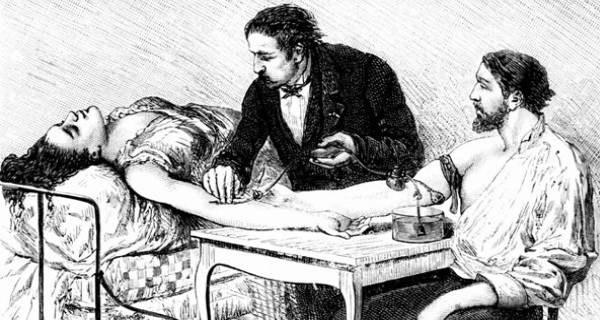Making a blood donation at a Vitalant location today means being welcomed into a clean, modern facility; screened thoroughly to ensure your safety and blood recipients’ safety; made comfortable in a donor chair; and hooked up to sterile blood donation equipment.
But like many discoveries that occurred centuries before modern medicine was established, the early history of blood transfusion is, frankly, a bit creepy and gross, and may make you more squeamish than the sight of blood or needles. Nevertheless, in the interest of imparting some interesting trivia you can dazzle your friends with, here’s an abbreviated blood donation history.
Yes, They Really Did Use Leeches
“Bloodletting” as a way to cure everything from sore throats to the plague is believed to have started in ancient Egypt, and it continued through the 1800s. We’ve all heard the stories or seen the movies poking fun at using leeches for this practice – which is actually one of the more humane ways bloodletting occurred. Did you know that barbers became the go-to for bloodletting in medieval Europe, and that’s the reason their poles were red and white?
Bloodletting eventually was replaced by safer methods of fighting illness, but unfortunately not before our first president likely succumbed to overzealous use of this method. According to some historians, George Washington asked to be bled after he fell ill Dec. 13, 1799. He died the next day after doctors had drained an estimated 5 to 7 pints of his blood in less than a day. The average human body contains about 10 pints of blood, so knowing what we now know, losing that much blood likely contributed to Washington’s demise.
The first blood transfusion on record was performed in 1665 – between dogs. Two years later, successful transfusions from lambs to humans were reported in Europe, but that method eventually was banned because of transfusion reactions.
Finally, Human-to-Human Transfusion
In 1818, British obstetrician James Blundell figured out how to provide his female patient with blood from her husband using a syringe. He performed 10 transfusions in his career, half of which helped his patients (back then, 50/50 odds were better than the alternative). Early transfusion attempts were frequently plagued by adverse reactions.
The discovery of three different human blood groups – A, B and C (later changed to O) by Austrian physician Karl Landsteiner in 1900 was a huge leap forward for blood transfusion medicine and won him the Nobel Prize. His colleagues discovered group AB a couple years later. This led to numerous discoveries that paved the way for modern blood transfusion, including: crossmatching blood types to improve safety, type O as the universal donor and type AB as the universal recipient, how to indirectly transfuse blood (instead of person to person) and various ways to preserve blood.
Blood Banking in the U.S.
The first blood bank in the U.S. was started at Cook County Hospital in Chicago in 1937 by Bernard Fantus, who also coined the term “blood bank.” This led to blood banks popping up in other big cities. Landsteiner and his cohorts again pushed the field giant leaps forward by discovering the Rh factor (that “+” or “–” next to your blood type) which turned out to be the main cause of transfusion reactions.
It’s African American physician Charles Drew, however, who is credited as the father of the modern blood bank. Those early blood banks did not have standardized ways of collecting, testing, preserving and handling blood. Drew earned his Doctor of Medical Science degree in 1940 at Presbyterian Hospital in NYC based on his seven months studying not only these aspects of creating a successful blood bank, but also the recruiting and screening of donors and training of collection staff.
During World War II, Drew developed and led the Blood for Britain program, a U.S. effort to send blood plasma overseas to help wounded soldiers and civilians. This led to a national blood banking pilot program in 1941, for which Drew briefly served as assistant director (he also came up with the concept of bloodmobiles during this time!).
Drew’s accomplishments were especially notable because they came during a time when segregation or exclusion of Blacks from many aspects of society was the norm. In fact, the initial national blood program did not accept blood donations from Blacks and later separated their donations from the rest of the populations’, a practice without any scientific basis that Drew vehemently opposed and protested. This practice stopped around 1950.
Blood Banking Today
The growth of blood banks across the nation continued, as did innovations in the field, in leaps and bounds through the 1940s and 50s and beyond. Notable accomplishments include the invention of the blood bag instead of glass bottles to collect and store blood, and apheresis procedures for collecting different blood components. Blood and blood safety research continue to evolve, and the Vitalant Research Institute plays a big part in this aspect.
We can thank all these researchers and innovators for the safety of the blood donation and transfusion process today. But there is one thing no one has discovered yet – how to create a substitute for blood. That’s why regular blood donation by blood donors like you continues to be vital.
There is a constant need for blood and platelet donations, which have shelf lives and must come from human donors. You can help by scheduling your blood donation today.
Published by: Taitia S. — Vitalant Contributor

